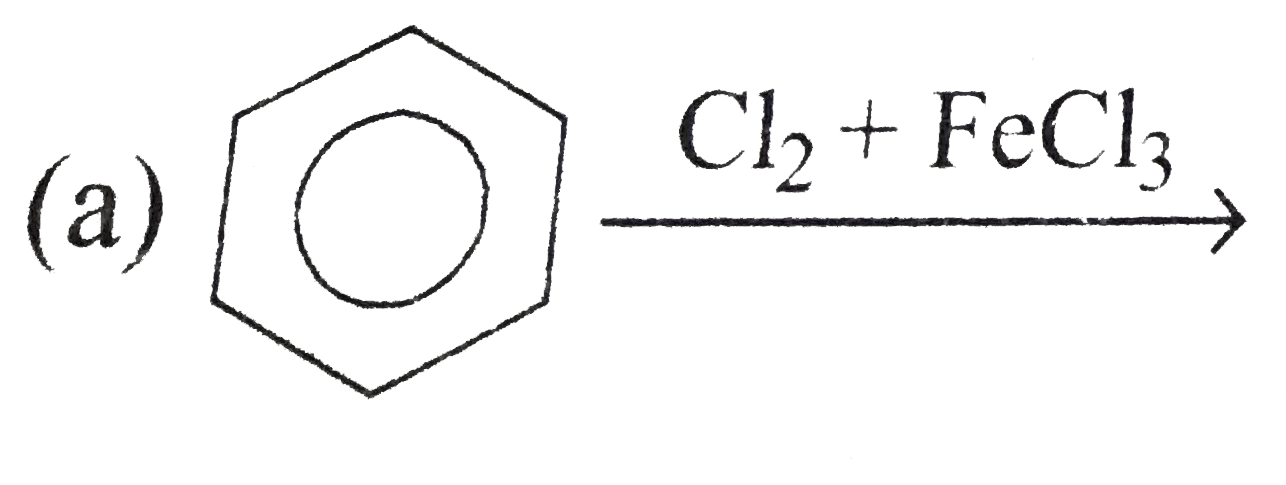Which of the following reactions involve free radical as intermediate ?




The correct Answer is:B, C, D
To determine which of the reactions involve free radicals as intermediates, we can analyze each reaction step by step.
Step 1: Analyze Reaction A (Benzene with Cl2 and FeCl3)
- In this reaction, benzene reacts with chlorine (Cl2) in the presence of iron(III) chloride (FeCl3).
- The FeCl3 acts as a Lewis acid and facilitates the formation of the electrophile Cl+.
- The mechanism involves the formation of a carbocation intermediate, not a free radical.
- Conclusion: This reaction does not involve free radicals.
Step 2: Analyze Reaction B (Alkane with Br2 in sunlight)
- In this reaction, bromine (Br2) reacts with an alkane in the presence of sunlight.
- The sunlight provides energy for the homolytic cleavage of the Br-Br bond, generating two bromine radicals (Br•).
- The bromine radical then abstracts a hydrogen atom from the alkane, forming an alkyl radical (R•).
- The alkyl radical can then react with another bromine radical to form the bromoalkane (RBr).
- Conclusion: This reaction involves free radicals as intermediates.
Step 3: Analyze Reaction C (Alkene with N-bromosuccinimide, NBS)
- In this reaction, N-bromosuccinimide (NBS) reacts with an alkene.
- The N-Br bond in NBS can undergo homolytic cleavage to generate a bromine radical (Br•) and a nitrogen radical (N•).
- The bromine radical abstracts a hydrogen atom from the alkene, forming an allylic radical.
- This allylic radical can then react with another bromine radical to form the brominated product.
- Conclusion: This reaction involves free radicals as intermediates.
Step 4: Analyze Reaction D (Silver Acetate with Br2 in CCl4)
- In this reaction, silver acetate reacts with bromine (Br2) in carbon tetrachloride (CCl4).
- The Br-Br bond undergoes homolytic cleavage to form bromine radicals (Br•).
- The silver acetate can interact with the bromine radical, leading to the formation of a radical on the acetate.
- This radical can then rearrange or react further, involving free radical mechanisms.
- Conclusion: This reaction involves free radicals as intermediates.
Final Conclusion
Based on the analysis:
- Reactions that involve free radicals as intermediates: B, C, and D.
- Reactions that do not involve free radicals: A.
Answer: B, C, D involve free radicals as intermediates.
---
- In this reaction, benzene reacts with chlorine (Cl2) in the presence of iron(III) chloride (FeCl3).
- The FeCl3 acts as a Lewis acid and facilitates the formation of the electrophile Cl+.
- The mechanism involves the formation of a carbocation intermediate, not a free radical.
- Conclusion: This reaction does not involve free radicals.
- In this reaction, bromine (Br2) reacts with an alkane in the presence of sunlight.
- The sunlight provides energy for the homolytic cleavage of the Br-Br bond, generating two bromine radicals (Br•).
- The bromine radical then abstracts a hydrogen atom from the alkane, forming an alkyl radical (R•).
- The alkyl radical can then react with another bromine radical to form the bromoalkane (RBr).
- Conclusion: This reaction involves free radicals as intermediates.
- In this reaction, N-bromosuccinimide (NBS) reacts with an alkene.
- The N-Br bond in NBS can undergo homolytic cleavage to generate a bromine radical (Br•) and a nitrogen radical (N•).
- The bromine radical abstracts a hydrogen atom from the alkene, forming an allylic radical.
- This allylic radical can then react with another bromine radical to form the brominated product.
- Conclusion: This reaction involves free radicals as intermediates.
- In this reaction, silver acetate reacts with bromine (Br2) in carbon tetrachloride (CCl4).
- The Br-Br bond undergoes homolytic cleavage to form bromine radicals (Br•).
- The silver acetate can interact with the bromine radical, leading to the formation of a radical on the acetate.
- This radical can then rearrange or react further, involving free radical mechanisms.
- Conclusion: This reaction involves free radicals as intermediates.
Based on the analysis:
- Reactions that involve free radicals as intermediates: B, C, and D.
- Reactions that do not involve free radicals: A.
Topper's Solved these Questions
- HALIDESBook:HIMANSHU PANDEYChapter:HALIDESExercise:Linked Comprehension Type (Q.1 To Q.25)
Explore 25 Videos
- HALIDESBook:HIMANSHU PANDEYChapter:HALIDESExercise:Linked Comprehension Type (Q.26 To Q.27)
Explore 2 Videos
- HALIDESBook:HIMANSHU PANDEYChapter:HALIDESExercise:More Than One Correct (Q.1 To Q.25)
Explore 25 Videos
- GENERAL ORGANIC CHEMISTRYBook:HIMANSHU PANDEYChapter:GENERAL ORGANIC CHEMISTRYExercise:Subjective Type Problems
Explore 19 Videos
- ISOMERISMBook:HIMANSHU PANDEYChapter:ISOMERISMExercise:Subjective Type Problems
Explore 11 Videos
Similar Questions
Knowledge Check
Which of the following reacts with free radical ?
AhypnoticsBantipyreticsCantibioticsDantioxidantWhich of the following reactions involve benzyne intermediate?
A B
B C
C D
D
Which of the following reactions involve carbanion enolalte as reactive intermediate?
AKolbe-Schmidt reactionBReimer-Tiemann reactionCClaisen condensationDAldol condensation
Which of the following is/are true for a free radical?
View SolutionWhich of the following is the most stable free radical?
View SolutionWhich of the following is the most stable Cation
View SolutionWhich of the following reactions are completed through free radical intermediate ?
View SolutionWhich of the following is not a free radical ?
View Solution

